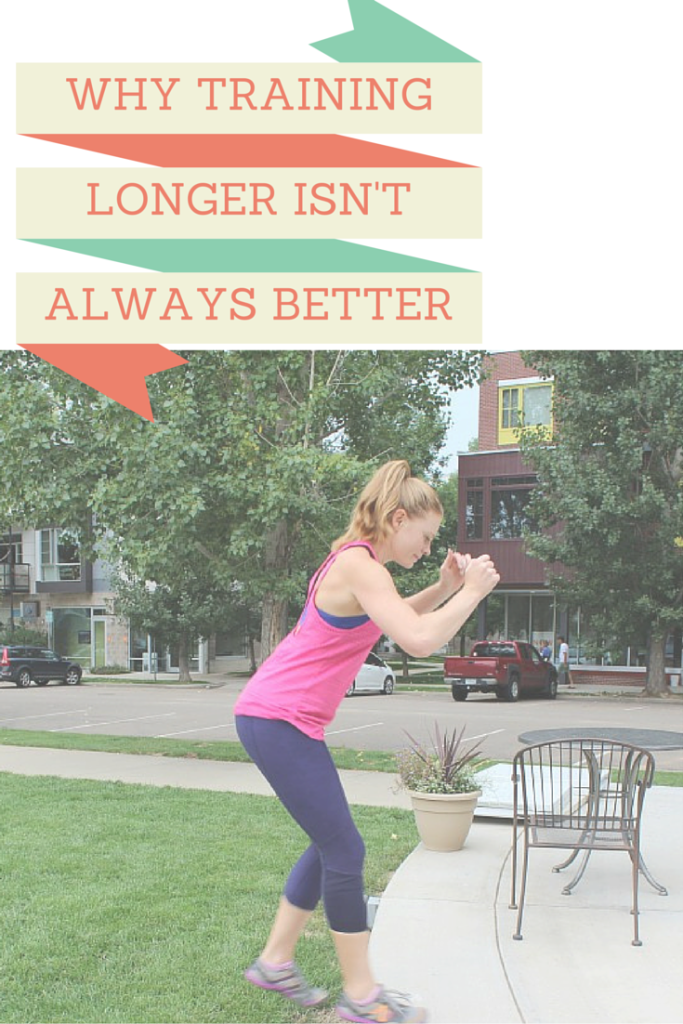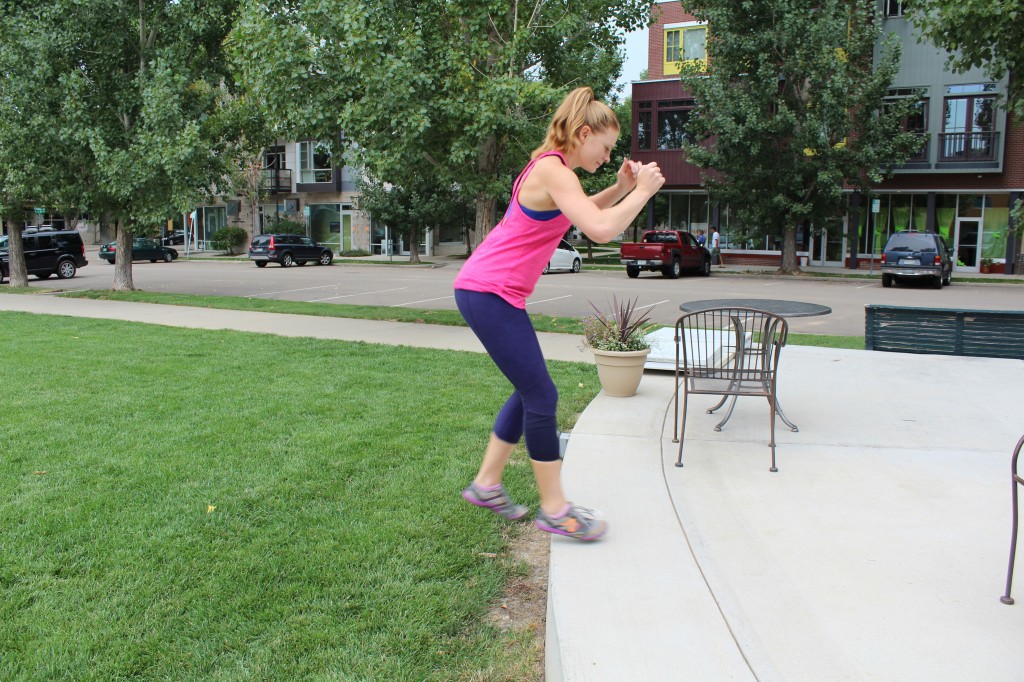Some thoughts and discussions from me.
Fun fact! Did you know I used to train for and run half marathons? I actually wrote about it a lot on this blog (well, the one before it – Running Around Normal) if you care to scour the archives circa 2011 (ya know, if you have a super boring day at work and nothing to do, haha.)
Anyway, it started with my completing the couch 2 5k program, which I still to this day recommend to clients who really want to get into running. I ran a few 5k’s, and caught the running bug. Naturally, I became obsessed, and in order to progress I signed up for 10k next, then a 15k, and finally on to half-marathons.
Now, while I totally understand that some people love distance running, I am neither one of those people (anymore) nor am I an advocate of it. )And while I’m not one to judge, nor stop someone of doing something they love, if someone truly asks me for advice, I’ll make the argument against distance running ((for most people – some people are just built for it and do fine with it – but they’re far and few between.)
Why? Well, along with my training, came plantar fasciitis, bursitis in my hip, dehydration, way too much training, and overtraining. Basically, training for my half marathons broke my body. And that was with just training for a half – and I’m not alone here. I have a couple clients and have had many a clients with the same woes.
So I did what was best for me and quit distance training, and my body has been happier because of it. Long story short, I learned that it’s not necessarily always better to train longer to progress my workouts – and that goes for both cardio and strength training.
[Tweet “Why Longer Isn’t Always Better – via @TrainerPaige”]
Yes, adding sets and reps onto your workout is a fantastic way to challenge yourself and to progress your workload. But -it’s not the only way, and it’s not always the best way.
The Problem with Training Longer to Progress a Workout
The thing is, it’s easy to train longer. All you have to do is add more minutes, miles, sets, or reps! But there’s a couple problems with simply training longer:
1. The risk of injury.
As I mentioned above, simply adding more and more miles to progress my cardio through running was doing nothing but running myself into the ground. However, even if it’s not running, adding more and more runs a big risk for injury – especially with ballistic strength+conditioning exercises.
Take the kettlebell swing, for example. It’s gaining a huge popularity, but it’s an extremely complicated movement. I myself won’t do more than 15-20 in a single period, simply because of the nature of the movement – and I know how to perform it with good form! And don’t get me started on doing box jumps for cardio (box jumps are a POWER exercise, and should be used as such – not for conditioning.)
Performing a challenging exercise for a long amount of time or a high amount of reps is simply setting oneself up for injury. Again, adding an extra set of squats or two isn’t going to automatically set you up for injury, but after a certain point, it, too, can get excessive.
2. You could be doing yourself a disservice.
If you want to get better at something – whether it’s a specific movement or exercise or it’s increasing your anaerobic capacity/strength/etc. try progressing the movement instead of making it longer. (Again – the caveat here is if you are training for an endurance event.)
As far as physique, power, and strength goes, there’s a considerable amount of research saying that shorter, more intense bouts of exercise is the way to go!
So, how do you progress your training if you aren’t going to lengthen it?
First of all, practice safety before anything else. Ensure your form is impeccable, you aren’t over training, and you’re not pushing yourself harder than you can work. This is extremely important. That said, here are some different ways to progress your training to make it harder:
1. Shorten your rest periods.
This is actually one of my favorite methods when it comes to metabolic circuits. If you finish a set of 15 push presses, and need a full minute to recover before moving on to your next set or exercise, push yourself to decrease that :60 to :50 next week.
2. Lengthen your rest periods.
Yes, I did just say the exact opposite in point #1. However, when it comes to conditioning, performing true HIIT intervals – double rest to work ratios, allows you to really push yourself during your work effort. Some of my very hardest conditioning workouts are when I’m doing a treadmill hill workout, and my rest break is double that of my work – or longer! This ensures you give yourself enough time to fully recover, so that you can really go hard at it again. Then, over the next couple of weeks, see if you can work at the same interval/speed/incline, etc. and decrease the rest. If you can, it might be time to bump up the intensity again.
3. Increase your range of motion.
If if feels ok, go ahead and make your movements bigger. Use your arms while going into your squat jumps. Sink down a little further into your squats, etc. The extra movement and range of motion will produce a bigger workload.
4. Add power
Adding power, so long as it’s safe, will skyrocket the intensity of any exercise! If you’re a pro at push ups, perhaps you could give explosive push ups a try. If you’ve mastered the step up, maybe it’s time to try the plyo step up.
Again, adding sets and reps to your workout and making it a little longer isn’t necessarily a bad thing. I’m just saying it’s not the only way to progress, and it’s definitely not always the best way!
[Tweet “Why Longer isn’t Always Better When it Comes to Workout Progression via @TrainerPaige #fitfluential”]
What’s your favorite way to turn up the intensity on a certain workout?






All great tips! I do think the best way for effective change are by amping up the intensity, not putting yourself through a longer workout!
Hey Paige,
Thanks for sharing! I’m just wondering that maybe you got injured when you trained for your half marathons because your body was not ready for longer workouts? It takes time to build up the endurance and get your muscles and joints ready for longer runs.
But I totally agree that you can get great results with short power / conditioning workouts, that’s for sure!
I typically followed Hal Higdon’s training plans for progressing mileage.
So true. We do tend to associate progression with doing more/going further when it’s not always the case. And I love your suggestions for how to progress your training without just adding on top of it.
Christine @ Love, Life, Surf recently posted…Why It Matters
I’m right there with ya on the long distance running! My body just doesn’t love it. Maybe someday I’ll get the itch to train for a half marathon again, but it won’t be for a long while. 😉 Love your tips to intensify workouts!
Ashley @ My Food N Fitness Diaries recently posted…The Thing About “Healthy Living Blogs”…
I tried several times to get into running, but it just wasn’t going to happen. I’m prone to plantar fasciitis, which isn’t much fun to deal with.
Fiona @ Get Fit Fiona recently posted…What I Ate Wednesday
Wow! Its crazy that I ran across this post today. A friend of mine talked me into doing the Tough Mudder. I was all in, increased my cardio sessions to 2-3 hours a day 5 days a week. I was getting stronger, my endurance was improving, but my body ached pretty bad. I added more rest days but no matter what I did it hurt just to get up in the morning, my knees were constantly sore and I got shooting pains in them whenever I walked up stairs, which sucked because I live in a 3 story walk up . Then I became uninspired and wanted to give up. I didn’t exercise for 2 weeks and created many excuses. I decided this week that I’m not going to do the Tough Mudder and for the last few weeks I’ve been doing interval & HIIT training Power Yoga, Bikram Yoga, and Kettle bells. I’m so much happier with my workouts. I actually enjoy them, and my body doesn’t ache as much as it used to.
This is really interesting. I’ve run quite a few marathons, and I raced the Ironman twice, and they always wiped me out for a lot longer than the people around me. I always thought I didn’t train enough to really be ready, but I wonder if my body is just made for shorter distances…